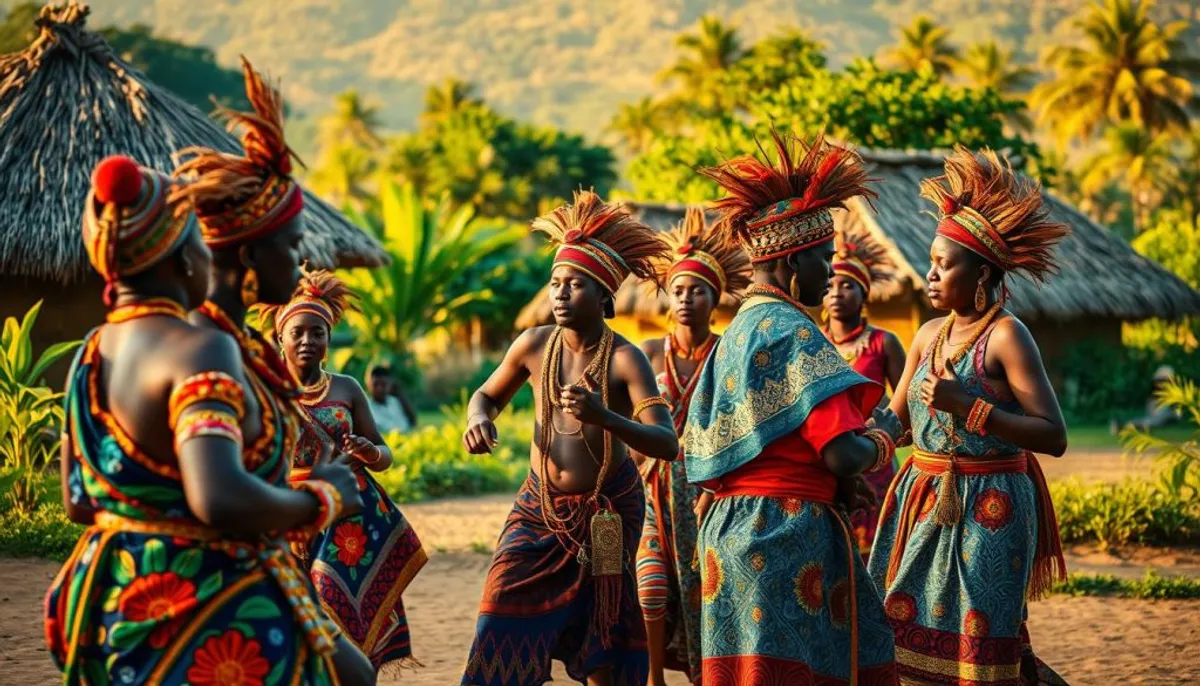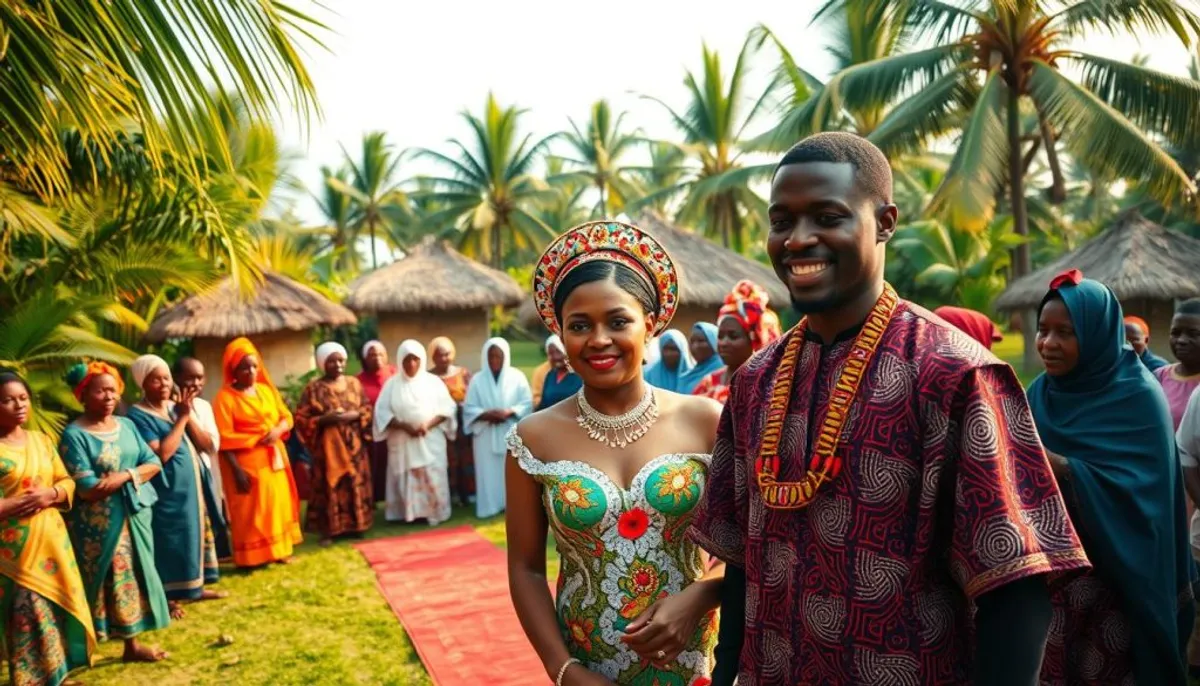The Baoulé people, originally from Côte d'Ivoire, fascinates with its rich culture and unique traditions. Settled in the heart of the country, the Baoulé form a community of around three million people, belonging to the larger Akan ethnic group.
What is Baoulé culture? It is distinguished by its matrilineal social organization, deep spiritual beliefs, and renowned art. The Baoulé traditions, passed down from generation to generation, testify to a tumultuous history and remarkable adaptability.

From the famous exodus led by Queen Abla Pokou at the end of the 18th century to the refined sculptures that have made them famous, the Baoulé have managed to preserve their identity while adapting to changes. Their society, organized around independent villages, reflects a flexible political structure and great cultural diversity.
Let us dive together into the fascinating world of this people, where art, spirituality, and traditions intertwine to form a culture that is as rich as it is captivating.
The history and origin of the Baoulé people
The history of the Baoulé people, an Ivorian ethnic group, dates back to the 18th century. This group has created a distinct identity, navigating through challenges and victories.
The legendary Queen Abla Pokou and the Baoulé exodus
Queen Abla Pokou is at the center of Baoulé history. She led her people in a difficult migration between 1701 and 1706. The name “Baoulé” comes from a tragic sacrifice. The queen sacrificed her son to save her people. “Ba ou li,” meaning “the child is dead,” became the name of this courageous ethnic group.
The settlement in central Côte d'Ivoire
After their migration, the Baoulé settled in central Côte d'Ivoire. Their territory, Baouléman, covers about 30,000 km². It includes key cities such as Bouaké, Yamoussoukro, and Toumodi. This fertile region has nourished their thriving culture.
The formation of Baoulé sub-groups
Over time, the diversity of the Baoulé ethnic group has emerged. Today, there are about 20 sub-groups. Each has its specificities but shares a common language. This diversity enriches their cultural heritage, ensuring their vitality and resilience.
What is Baoulé culture
Baoulé culture is deep and complex, reflecting their daily life and ancestral traditions. This ethnic group, making up about 18% of the Ivorian population, occupies a vast territory of over 32,000 km² in the heart of Côte d'Ivoire.
The traditional social and political organization
The Baoulé society is structured around a complex hierarchy. Villages, led by chiefs, form the core of social life. With an average population density of over 32 inhabitants per square kilometer, the Baoulé community appears dynamic and united.
The central role of women in Baoulé society
Women play an essential role in Baoulé culture. They are heavily involved in family and community decisions. Their influence extends to various areas, from child education to the management of family resources.
Spiritual beliefs and practices
The Baoulé spiritual universe is divided into three distinct realities. The firmament is the domain of God (Annangaman Nyamien), the earthly world houses living beings and spirits, while the beyond (blôlô) is the place of ancestors. These beliefs shape the community's daily practices and rituals.
The daily life of the Baoulé is marked by these traditions. Customary marriage, for example, is divided into three symbolic stages. The dowry, reinstated, includes offerings such as bottles of gin and pagnes, reinforcing family ties. The influence of traditional Japanese art is also felt in some artistic practices.
The artistic and craft traditions
Baoulé art is a pillar of Baoulé traditions, showcasing the cultural depth of this Ivorian people. With over 3 million people, the Baoulé stand out for their expertise in various artistic fields. These skills are crucial in their Baoulé customs.
Baoulé sculpture and masks
Baoulé sculptors are known for their expertise. They shape Waka-Sona statues, or “wood beings,” which evoke the assié oussou in rituals. The ndoma masks, on the other hand, symbolize harmony between the sexes. Their value varies, ranging from 100 to 9900 euros on online platforms.
Goldsmithing and gold work
Gold plays a predominant role in Baoulé art. Artisans excel in creating jewelry and decorated gold objects. These pieces reflect heritage, opulence, and power in Baoulé society. Weights for weighing gold are symbols of this exquisite craftsmanship.
Traditional pagnes “wawlé tanni”
Baoulé fabric, or “wawlé tanni,” is essential in Baoulé traditions. Its patterns, geometric or natural, carry deep meanings. The fabric is used in important ceremonies and has found its place in contemporary fashion, notably with Taniabel.
| Type of art | Characteristics | Cultural significance |
|---|---|---|
| Sculptures | Waka-Sona statues, ndoma masks | Ritual, social harmony |
| Goldsmithing | Jewelry, gold objects | Power, opulence |
| Weaving | “Wawlé tanni” pagnes | Unity, strength, ceremonies |
Important celebrations and rituals
Baoulé traditions are distinguished by a multitude of celebrations and rituals. These events play a crucial role in daily life and education. They serve to preserve customs and solidify community bonds.
The Paquinou festival
The Paquinou festival is a key moment for the Baoulé. It takes place over three days, around Easter. This celebration allows the Baoulé to reconnect with their roots by returning to their villages. It is an opportunity to strengthen family ties and share culture.

Traditional dances: Goli and Adjémlé
The Goli and Adjémlé dances are essential elements of Baoulé customs. The Goli, with its colorful masks, is a sacred dance. It is performed during major events. The Adjémlé, on the other hand, is a festive dance that animates village celebrations.
The ceremonies for the installation of chiefs
The installation of a Baoulé chief is a fundamental ritual. This ceremony, laden with symbols, marks the transfer of power. It symbolizes the renewal of traditional authority. It contributes to social cohesion and the perpetuation of ancestral values.
| Celebration | Duration | Particularity |
|---|---|---|
| Paquinou | 3 days | Return to the village |
| Goli Dance | Variable | Sacred masks |
| Adjémlé Dance | Variable | Festive atmosphere |
| Installation | 1 day | Ancestral rites |
The Baoulé language and names
The Baoulé language, spoken by 7,468,290 people, is an essential foundation of Baoulé identity. It is part of the Niger-Congo family and uses the Latin alphabet, with specific adaptations. These adaptations are derived from the Practical Spelling of Ivorian Languages.
The Baoulé vocabulary is remarkably rich. It includes over 40 terms for tropical plants and a numerical system up to 20. This language reflects the unique vision of the environment by the Baoulé, with a classification of colors into three main categories.
Baoulé names are deeply rooted in culture. They are often linked to the day of birth. For example, a child born on a Monday may be named Kuasi (boy) or Akisi (girl). The order of birth also influences first names: the ninth child of a mother is named N'goran, the tenth Brou.
The circumstances of birth are crucial for name attribution. A child born during a race outside the home might be called Atoumgbré. Names can also reflect physical traits or natural elements, like Gbamlé for a redhead or Kongo meaning “valley.”
This linguistic and onomastic depth underscores the importance of language in preserving Baoulé cultural identity. It represents 23% of the Ivorian population, highlighting the significance of language in culture.
The matrimonial system and family life
The Baoulé customs regarding marriage and family life are deeply rooted. They emphasize the importance of family ties in traditional Ivorian society. These practices reflect a unique complexity and richness.
The different types of marriage
The Baoulé matrimonial system is divided into several categories of unions. The atovlè marriage, reserved for nobles, coexists with ordinary marriage. Research reveals that 30% of Baoulé opt for a marriage outside their ethnic group. This illustrates a trend towards openness and acceptance of diversity.

The importance of the extended family
The extended family plays a prominent role in Baoulé daily life. Nearly 60% of families adopt exogamy, seeking partners outside their family circle. The rules of marriage prohibition, based on genealogical considerations, affect up to 50% of unions between certain lineages.
Rites related to birth
The birth of a child is a crucial event in Baoulé traditions. It is marked by specific rituals to welcome the newborn into the community. These practices, passed down from generation to generation, constitute an essential element of Baoulé daily life.
The “Ivorian miracle” has marked matrimonial structures, with 20% of young adults observing changes compared to previous generations. This evolution demonstrates the ability of Baoulé customs to adapt to social transformations.
Conclusion
The Baoulé people, a major ethnic group in Côte d'Ivoire, embodies a rich and fascinating culture. With a population of around three million individuals, the Baoulé form an important part of the Akan, representing 38% of the Ivorian population in 2021. Their history, marked by the legendary exodus led by Queen Abla Pokou in the 18th century, has shaped their unique identity.
Baoulé culture is distinguished by its complex social organization, comprising eight main clans and over twenty sub-groups. Their artistic traditions, notably sculpture, goldsmithing, and the weaving of the famous “wawlé tanni” pagnes, testify to exceptional craftsmanship. These pagnes, woven exclusively by men, are at the heart of a recognition process as a protected geographical indication.
Although the Baoulé people have integrated various cultural influences, including significant cultural influence from neighboring groups, they remain deeply attached to their ancestral beliefs. Traditional ceremonies like the sacred dance Djéla and Goli play a crucial role in their community life. The Baoulé language, belonging to the Akan language family, contributes to preserving their unique cultural identity within the diverse ethnic landscape of Côte d'Ivoire.
RelatedRelated articles


